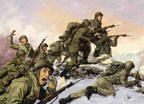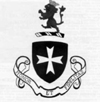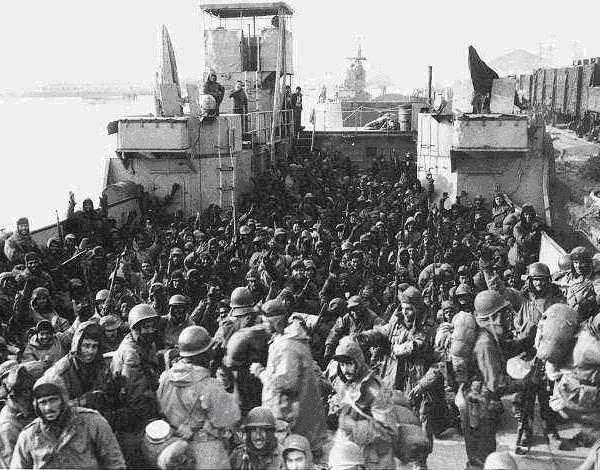Introduction
It
has been both euphemistically and derisively called an “attack in another
direction” and the “Big Bug-Out,” and candidly described as a
“miracle,” as “an exercise in improvisation,” and as “the first and only
amphibious operation in reverse” in U.S. military history; but the
unarguable truth is that the Hŭngnam evacuation stands alone as one of the
greatest epic campaigns of the Korean War. Over the course of two weeks,
the legendary and controversial X Corps would fight its way to the sea along
a harrowing route through the mountains of eastern North Korea, destroying
two Chinese armies along the way, before reaching the sanctuary of the
Hŭngnam beachhead, where it would integrate the 105,000 U.S., U.N. and
ROK military personnel, which,
along with 17,500 vehicles, 350,000 tons of cargo, and 91,000 refugees, were
to be evacuated in the largest sealift since World War II.
The time-honored maxim of the “first one in, last one out”
has never been so aptly embodied as it was by one small outfit of the 3rd
Division. The division’s vanguard regiment in Korea, it would also be the
corps’ rearguard during the corps’ evacuation. It went by the soubriquet
“The Borinqueneers.”
The
“Home-by-Christmas” Campaign
Failure
after failure had been the order of the day for the North Korean People’s
Army (NKPA) following the X
Corps’ successful landing at Inch’ŏn in September. Douglas MacArthur’s
United Nations Command (UNC) had
put the smashed remnants of the NKPA
in a rout north; had captured the North Korean capital of P’yŏngyang by
mid-October; and had been in hot pursuit of the communists ever since.
During the Wake Island meeting with President Truman, the general had
assured his commander in chief that the possibility of Chinese intervention
in Korea would be minimal. The Chinese commies would not attack; the allies
had won the war. The President could send a division to Europe from Korea
as early as January 1951.
The
“imminent” success, reasonably, inspired the Supreme Commander Allied Powers
(SCAP) and Commander in Chief,
United Nations Command (CINCUNC)
to utter the outrageous promise to have “the boys back home by Christmas.”
Per
MacArthur’s instructions, Lt. Gen. Walton H. “Johnnie” Walker, commanding
general of the Eighth U.S. Army, Korea (EUSAK),
and Maj. Gen. Edward M. “Ned” Almond, commanding general of the X Corps,
rushed their respective “armies” in a northward race to the Yalu River.
Whether they were to cross the river and carry the war into Manchuria
remained to be said. Neither man foresaw – perhaps both men rather chose to
overlook – the possibility that differences between the two forces, both
geographical and personally speaking, could seriously cripple their
collective effectiveness. Firstly, since its arrival in Korea, X Corps had
been operating as an independent army rather than assuming its subordinate
status to EUSAK.
Secondly, the commanders’ dislike for one another exacerbated this awkward
arrangement.
Parting from the premise that the communists were defeated and the boys
would be home by Christmas, the armies continued their advances in a total
of four parallel but dispersed columns, leaving the meridian part of Korea
open to … anything.
The
race to the Yalu came to an abrupt halt on the night of November 25, when
200,000 Chinese Communist Forces (CCF)
troops attacked the
EUSAK
lines.
Enter
the Dragon: Douglas MacArthur Pays Dearly
Rumors of an increasing Chinese intervention in the war had
spread like wild fire all over Korea – its flames lapping at the steps of
MacArthur’s General Headquarters in Tokyo, and its smoke starting to collect
in Truman’s office in Washington, D.C. MacArthur decided to hush the
rumors, preferring to save face and live up to his assertion at Wake
Island. Should it hit the fan, it had been his own G-2 who first
dismissed the possibility of Chinese intervention.
Having landed in North Korea at the end of October, the 7th
“Bayonet” Division’s 17th Infantry Regiment became the first unit
of X Corps to reach the Yalu unopposed.
South of the 17th, sister regimental combat team (RCT)
32nd had set up a forward command post east of the enormous
Changjin (Chosin) Reservoir. A stone throw south of the 32nd,
the 1st Marine Division sat astride the artificial reservoir
while headquartered at Hagaru-ri. The 31st RCT and the Republic
of Korea Army (ROKA) I Corps stretched in an arc anchoring the northeastern
part of the peninsula.
During a hasty visit to the 32nd RCT the day after the CCF attack
on EUSAK,
Ned Almond accepted the rumors, yet emphasizing that there were not two
divisions in the whole of North Korea. The Chinese they had been talking
about were
“nothing more than
some remnants of Chinese divisions fleeing north.” His X Corps was still
attacking and was going all the way to the Yalu. He further spurred his
commanders to continue and not to “let a bunch of Chinese laundrymen stop
you.”
The
plan had been that once North Korea had been cleaned up, the
ROKA would take over and the UNC would pull out of Korea. His
“incomprehensible” strategy now had X Corps fragmented across a huge front.
West
of the unguarded EUSAK–X Corps boundary, Johnnie Walker was unable to repel
the CCF onslaught. One dumbfounded Douglas MacArthur could only watch as
Walker’s decimated troops pulled a “180” back to the 38th
Parallel. East of the boundary, rumors became reality overnight: There
were not two Chinese divisions in North Korea, as Almond had said.
There were two armies!
Before long, on MacArthur’s orders, Almond was to instruct the 7th
Division forces on the Yalu to fall back on Hamhŭng, an industrial city
northwest of Wŏnsan, where the general had established his Corps
Headquarters. Once there, the rearguard division troops were to protect the
corps’ northern and northeastern flank, establishing a strong position 20
miles north of Hamhŭng, to block roads leading south out of the area to be
vacated. At the same time, the ROKA I Corps was to protect the right flank
and secure the east coast road as the forces completed their movements
south.
The Tip
of the Spear
The
65th Infantry Regiment had joined the war as a last-minute
addition to the 3rd “Rock of the Marne” Division before departing
Puerto Rico in August.
The division’s only regiment in Korea, it had been indiscriminately and
temporarily attached to the 2nd and 25th
U.S. divisions during EUSAK’s
IX Corps pocket-clearing operations along the Naktong Bulge for the latter
part of September and most of October. The glory it had been denied for
missing out on the Inch’ŏn landing came calling when the shorthanded X Corps
called for additional support in the invasion of North Korea.
Never had the 65th Borinqueneers imagined that
their disembarking on the beaches of Wŏnsan in the first week of November,
hard on the heels of the 1st Marine Division, would mark the
beginning of a new kind of war with a new “enemy”: the controversial Ned
Almond. Not only would they undeservedly win the prejudice and
discrimination of their new corps commander, but would be at his mercy as
well. No sooner had the regiment’s advance party landed than Almond
fragmented it, putting it under the operational control of X Corps without
notifying the regimental commander. By rushing Lt. Col. Herman W. Dammer’s
2nd Battalion (2/65) into the mountains of nearby Yŏnghŭng,
piecemeal and lacking adequate ammunition to repel the suspected enemy force
hiding there, Almond virtually delivered the outfit to the enemy on a silver
platter. An opportune spotter plane would save the day by alerting the
allies to the Borinqueneers’ presence and by arranging an airdrop that
permitted the Puerto Ricans to repel the enemy and return to Wŏnsan.
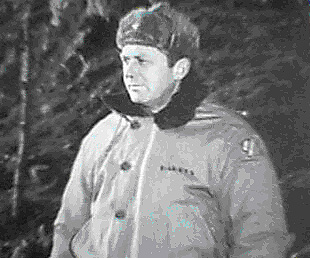
Col.
William W. “Bill” Harris, commander of the 65th Infantry Regiment.
Near
Wŏnsan, November 1950 (National Archives)
When
the rest of the regiment landed at Wŏnsan, Almond immediately scattered it
all over the place: one part to “palace-guard” his headquarters, another to
bodyguard the 1st Marine Division elements there, and the other
to prepare for a westward venture aimed to contact and assist the decimated
EUSAK in Tŏkch’ŏn, near the
infamous boundary. To Col. William W. Harris, commander of the 65th,
the words of his 1930 West Point classmate and crony Aubrey Smith a few
nights earlier (“I wouldn’t go where you are being sent unless the corps
commander gave me … at least four infantry divisions.”) cast an ominous
shadow in his near future. The corps commander would indeed have to
reinforce Bill Harris’ outfit with a corps-sized force. The 3rd
Division, about to complete its training in Japan, would not arrive until
mid-November. (The need of reinforcements in Korea deemed necessary the
inclusion of the 3rd Division.)
The Tale
of Two Task Forces
From
the moment the rest of Maj. Gen. Robert H. “Shorty” Soule’s 3rd
Division arrived in North Korea, it would go on to block the road coming
east from Sach’ang-ni, and to protect the Wŏnsan–Hŭngnam coastal strip.
Its principal mission centered on pocket-clearing the area after
NKPA troops and guerrillas had either
infiltrated or fallen behind when their units withdrew from the seaport. To
do this, the paratrooper general created four RCTs
from his three regiments (the 7th, the 15th and the 65th)
and the newly-assigned
ROKA 26th
Regiment. The ROKA 26th had been the first X Corps unit to face
– and be nearly annihilated by – the CCF
in October.
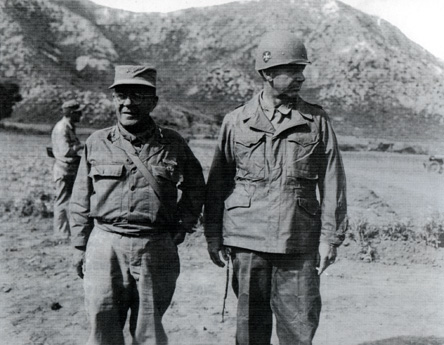
Maj. Gen.
Robert H. “Shorty” Soule, CG 3rd Division, and Col. Harris.
Wŏnsan,
November 1950 (National Archives)
In
the eyes of many, this relatively easy job would somehow hone on skills gone
dull over the postwar years. At this moment the 3rd was at an
alarming state of unpreparedness – “a mess!!!” [emphasis in the original] as
a Military Police sergeant assigned to the division’s 3rd
Military Police Company recalls. “The 7th [Infantry] was
effective from the landing, but the 15th was not an asset, and
sometimes a liability.” The first night ashore, a platoon leader from the
15th Infantry was accidentally shot by one of his own as the
officer checked the alertness of his men.
“As to the 65th,
they were well trained, well used, and could handle their own business.”
When asked how he expected to fight a war with so many untrained units,
Soule’s emphatic answer was that “in the army you led what you had, and
hoped for the best.”
As far as Bill Harris was concerned, an
AOR covering approximately 900 square
miles was too large to be effectively patrolled, let alone defended. His
three battalions were between thirty and forty miles apart, and visiting
them was likened to craving for a bullet on his part.
Heavy engagements erupted alongside the strip; nevertheless,
all enemy attacks were defeated.
The
fourth of December finally presented some “organization” and “direction” for
the 65th, which, for the first three days of the month had been
going back and forth aimlessly inside its AOR,
simply reacting to the changes of orders X Corps had been producing at
machine-gun speed.
The first operation order issued by 3rd Division called for the
Puerto Ricans to relieve the withdrawing 1st Marine Division and
to protect the Changjin Reservoir road from Sudong south to Hamhŭng from
fleeing
NKPA
forces launching diversionary attacks to draw UNC
forces away from the retreating troops. Reunited at Hŭngnam for the first
time since arriving in North Korea, the 65th was assigned the
following missions:
1) Preparing defensive positions on the CHARLIE Line, near
Oro-ri, eight miles northwest of Hamhŭng, from the boundary of the 7th
Division (on the right) to the GEORGE Line on the Tŏngsongch’ŏn River (on
the left) (1/65);
2) Opposing a large enemy force coming from the north;
3) Securing the village of Majŏn-dong, eleven miles north of
the CHARLIE Line (2/65);
4) Clearing the seven-mile stretch of the main supply route
(MSR) from Majŏn-dong to Sudong
of enemy forces (3/65); and
5) Protecting the withdrawal of the 1st Marine
Division headquarters from Hagaru-ri.
Ned Almond’s plan was for the 3rd Division to send
a forward covering force to Chinhŭng-ni, the halfway point of the 40-mile
road between Hagaru-ri and Hŭngnam; wait for the Marines to come barreling
down the mountains; and hold off the CCF
while the Marines withdrew to Sudong. Troops of 2/65 and 3/65 would meet
the withdrawing forces there, and would ensure their safe trucking and
entraining to the Hŭngnam harbor for evacuation to Pusan. The troops on the
perimeter line around “Liberty City” would then be withdrawn from CHARLIE
Line through a series of lines in successive delaying actions until
evacuating the 7th Division under the firing cover of the 3rd
Division’s rearguard.
To
assist the 65th in accomplishing its mission, Shorty Soule
assembled a powerful force commanded by his quick-tempered assistant
division commander, Brig. Gen. Armistead D. Meade. Task Force D (TF
Dog) incorporated elements of 3rd Battalion 7th
RCT, the 92nd
FAB, the 10th and 73rd
Combat Engineer battalions, and the 3rd Reconnaissance and 52nd
Transportation companies into what was likened to a “solve the
unsolvable” or “Cavalry to the rescue” enterprise.
If for whatever obscure reason TF
Dog’s role has gone relatively unrecognized, outshined by the glamour of the
heroic Marine role during the withdrawal, the role of sister task force
Childs has gone virtually inexistent. In fact, so closely intertwined have
been these task forces that yet many members of TF
Childs still believe they had operated under TF
Dog all along. Dubbed after its tactical commander, Lt. Col. George W.
Childs, regimental executive officer of the 65th, this
1,850-strong task force consisted of the core of 2/65 and 3/65, powerfully
supported by units of field artillery, engineer, armor and chemical. Thus,
while TF Dog’s mission would
consist of helping the Marines fight their way southward along the
withdrawal route, TF Childs’
would consist of holding the highlands in front and eventually to the west
of the MSR.
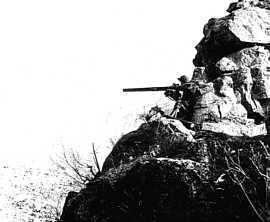
A 75-mm recoilless
rifle position guards the
MSR.
North of Hamhŭng, December 1950 (U.S.
Army Photo)
Another peculiarity accentuating these two forces’ uniqueness has to do with
their racial and ethnic composition of one-third Puerto Rican and two-thirds
black.
While there seems to be no consensus in points of view regarding Ned
Almond’s character, almost all agree in recognizing the general’s subjective
attitude toward “colored” soldiers, result of the disappointing performance
of his 92nd (Negro) Division from World War II. Whether racism
played a major factor in the constitution of task forces Dog and Childs, the
unarguable reality was that, excepting the 65th, the 3rd
Division troops were green to combat.
Soule was to concentrate the remainder of his division
between Chigyŏng and the C-47 Airfield in Yŏnp’o, about four miles southwest
of “Liberty City.”
Both
task forces hit the road in the wee hours of a freezing December 6,
spearheaded by Herman Dammer’s 2/65, which reached Majŏn-dong at 2:30 p.m.
and secured its roads and railroads until TF
Dog’s arrival. Relieved in place, part of 2/65 withdrew to Oro-ri to link
up with Lt. Col. Edward Allen’s 3/65, while George Company 2/65 led
TF Dog’s march north to Sudong. From
their respective positions along one ridge paralleling the road to Hamhŭng,
three companies of 3/65 controlled several miles of adjacencies.
The
Marines Advance in a Different Direction
The
situation up north grew bleaker by the minute. Bill Harris’ West Point
classmate Allan MacLean, regimental commander of the 7th
Division’s 31st RCT,
had been wounded and captured (and ultimately dead) by the
CCF; Lt. Col. Donald C. Faith,
commander of 1/32, had become a KIA;
and TF MacLean–Faith had been
utterly destroyed. The heroism of these men, nevertheless, had not been in
vain, as it had brought the virtual destruction of one
CCF division, allowing the 10,000
Marines and soldiers trapped around the Changjin Reservoir to reach the
relative haven of Hagaru-ri. All along, the “Bayonet” Division would lose
five senior combat commanders during this affair.
Cut off from supply lines and rapidly depleting their
ammunition, Marines and soldiers continued to be exposed and succumbing to
the extreme cold while being surrounded by entire divisions of better
outfitted and better situated fanatic communist troops. On one side, the
formidable terrain allowed the enemy to effectively isolate X Corps; on the
other, the freezing gusts seemed to strip of whatever strengths and fighting
spirit the withdrawing forces might have had during their initial victories
around Changjin. Men collapsed and preferred not to move thereafter,
proving essential for officers and sergeants to stay close to their men and
to drive them to respond even when under attack. Stragglers had to be
kicked and pushed. Whilst hopes of escaping the trap waned, the withdrawal
plan continued as planned.
“We
are just advancing in a different direction,” had been Marine Maj. Gen.
Oliver Prince “O.P.” Smith’s response to a war correspondent when questioned
about the retreat. Firstly, the word was anathema in the Marine Corps
doctrine. Secondly, there was no rear where to retreat to. A toughened
version of O.P.’s candid answer entered the Marine Corps history as, “Retreat,
hell! We’re just attacking in another direction!” New York Herald
Tribune’s Marguerite Higgins, probably the most famous war correspondent
in Korea, and Life Magazine war photographer David Douglas Duncan had
flown to Hagaru-ri to cover the epic withdrawal, but Higgins had been forced
to leave on grounds of her gender and the harrowing hardships yet to be
faced.
It would be partly up to former Marine Duncan to make the Marines withdrawal
the most famous episode of the Korean War.
The
forces departed Hagaru-ri on December 6, stopping briefly at Kot’o-ri,
eleven miles south, while waiting for an airdrop of bridging materials. The
village of Chinhŭng, farther south, marked the first half of their
withdrawal and the rendezvous point with the TF
Dog elements.
During the winter of 1950, which stands as one of the coldest in recorded
history, both warring factions endured the extreme cold weather’s effect not
only upon themselves but upon combat capability as well. Frostbite proved
just as dangerous as the malfunctioning of weapons. Recent declassified
documents show that while the communists had found a way to counter the
malfunctioning of weapons, frostbite remained the gravest enemy by far,
proving more lethal than the formidable overall superiority of the UNC.
For the majority of the warm-blooded Borinqueneers seeing
snow for the first time, the challenge of coping and surviving presented but
an opportunity to employ their resourcefulness. Dressing in layers
compensated for the lack of right winter equipment; carrying their ration
cans under their armpits kept the food warm enough for eating; and keeping
their canteens under their clothing kept the water usable. Individual
weapons were maintained relatively dry. The men had learned that an excess
amount of grease or oil allowed to remain on weapons after they were cleaned
called for a jam and failure to fire. The trick to keep mortar tubes from
shrinking or cracking consisted of setting the mortar base plates on top of
furnaces dug in on the ground and keeping the tubes covered with tarpaulins
until ready for use. In extreme cases, crew-served weapons had to be
urinated upon to be thawed for operation. This exceptional performance in
subzero temperatures so impressed Harris that he would go on to publicize
his men everywhere they went in Korea. Somebody had been selling the Puerto
Rican soldier too low.
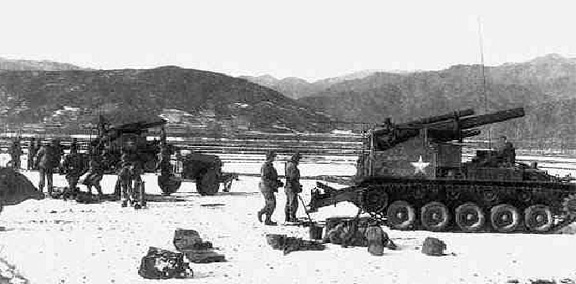
TF
Dog’s 92nd FAB elements
support the Marines’ withdrawal.
Chinhŭng-ni, December 1950 (National Archives)
By
December 10 the withdrawing column had grown up to 15,000 men.
CCF hordes were already breathing down
their necks when they came under the protection of the forward infantry and
tank elements of TF
Dog on the outskirts on Chinhŭng-ni. For those men – bearded, starving and
frostbitten – “it sure was a wonderful sight to see friendly troops on the
ridges.”
The sight was even more ecstatic by the time they reached the 3rd
Division perimeter. There, as many as possible were put on some of the 110
trucks provided for the rescue and driven back to Hŭngnam, yet many had to
continue walking. For those, many of whom had not slept in days, the ordeal
was just a bit far from over.
By
the time they reached Sudong, the western highlands of the
MSR for the next seven miles south had
already been secured by the Borinqueneers. The two-month head start in
Korea had given these the astuteness when facing an enemy who relied so much
on terrain features. The tactic they employed to secure the
MSR was the “mouse trap,” which
consisted of faking a retreat along the level grounds of a valley in order
to lure the CCF into a chase,
and once the CCF were well
inside, other Puerto Ricans came swarming down from the highlands,
encircling and annihilating the enemy. By doing this, they had softened the
Chinese pressure enough to allow the Marines and soldiers to get hold of the
highlands and cover the passage of their tanks and vehicles.
“Two
Battalions!”
Men
took advantage of every moment of calm to doze off. Some slept sitting up,
back to back with their buddies; others hugged the warm hoods of the
vehicles. David Duncan had a ball on account of the misery of the men, and
busied himself in taking pictures of his revered “leathernecks,” almost
entirely ignoring the 2,300 “doggies” in the column. In what might be taken
as a paradigm of poetic justice, one of his pictures of soldiers would be
immortalized in a 1985 United States Postal Service Korean War Commemorative
Stamp. Misidentified in Clay Blair’s The Forgotten War as a medical
platoon from 2/31, the squad featured in the picture was “not Marines,” but
“soldiers belonging to a Reserve unit, according to what they told me, from
Puerto Rico,” as Duncan himself remarked in the December 25 edition of
Life.
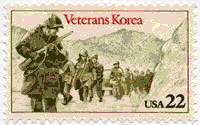
U.S.
Postal Service Korean War Commemorative Stamp (1985)
depicting soldiers of
the 65th Infantry Regiment (USPS)
Despite their excellent performance, the Puerto Ricans could not guarantee
every yard of the way. Later that afternoon and early evening,
CCF elements cut the road, halting the
column. In the ensuing battle the Chinese inflicted about twenty Marine
casualties and destroyed nine trucks. Two Army lieutenant colonels broke
the CCF block; yet the
withdrawal would not proceed undisturbed. TF
Dog’s 3/7 and George/65 would continue to hold off more
CCF attacks throughout the night. The
final group of Marines and soldiers had passed George/65’s defense
positions, the northernmost, when the company was ordered to withdraw and
serve as rearguard for the main body of troops at Majŏn-dong. The order to
cover the company’s withdrawal fell ultimately on Sgt. First Class (Sfc.)
Félix G. Nieves’ platoon, with Nieves’ own squad to cover the withdrawal of
the platoon. As the platoon was completing its withdrawal, an enemy attack
in force developed. Nieves ordered his men to withdraw as he alone defended
the position. In the face of heavy enemy machine gun and small arms fire,
the sergeant killed at least eighteen Chinese before the remainder force
became confused and fled, allowing Nieves’ squad to gain the safety of the
retreating column. Such display of bravado saved the lives of his fellow
Borinqueneers.
While those actions took place up north, the final elements
of the 1st Marine and 7th divisions at Majŏn-dong
boarded trains and trucks in the beginning of their final leg of the trip.
The Borinqueneers gave what food they could spare – mostly C ration sundries
like jelly, biscuits, mustard, fruits, and so forth. For many a starving
soul, a biscuit smeared with mustard likened to a banquet. The withdrawing
troops could not be any more grateful for the gesture of camaraderie
surpassing service branch differences. It is said that when one surprised
Marine officer asked how many divisions had come and the answer was, “Two
battalions from the 65th; Puerto Ricans,” his reaction was, “Two
battalions! But they fight as well as we do!” Clearly, despite
their reversal, the Marines conserved their traditional pride.
Marines and soldiers continued south under the protection of the Puerto
Ricans, all along expecting to defend the sector of “Liberty City” before
their ordeal was over. Unbeknownst to them, the plan to evacuate X Corps
was already in effect. Whereas the CCF
did not seriously interfere with the withdrawal at this point, the
prospective threat they represented called for a vigorous bombardment by
naval gunfire and carrier-based Navy and Marine aircraft. Additional air
cover was available from the C-47 Airfield.
Nocturnal attacks continued throughout the week along the route. At
midnight of the eleventh, elements of Baker/65 faced off a 300-strong
Chinese force north of CHARLIE Line. The Borinqueneers, logically, repelled
the attack; but the CCF
would attack again on the fifteenth, forcing Baker/65 to withdraw to higher
grounds. In the process, the company commander, wounded, fell behind and
refused to be evacuated from the now enemy-held territory. Disregarding his
own safety, a young corporal went back to rescue his commander. No sooner
had he brought the officer back into the company’s position than friendly
artillery and mortar fire started to fall on or near Baker. The corporal
once again volunteered to cross no-man’s land in order to reach a nearby
friendly command post and stop further attacks.
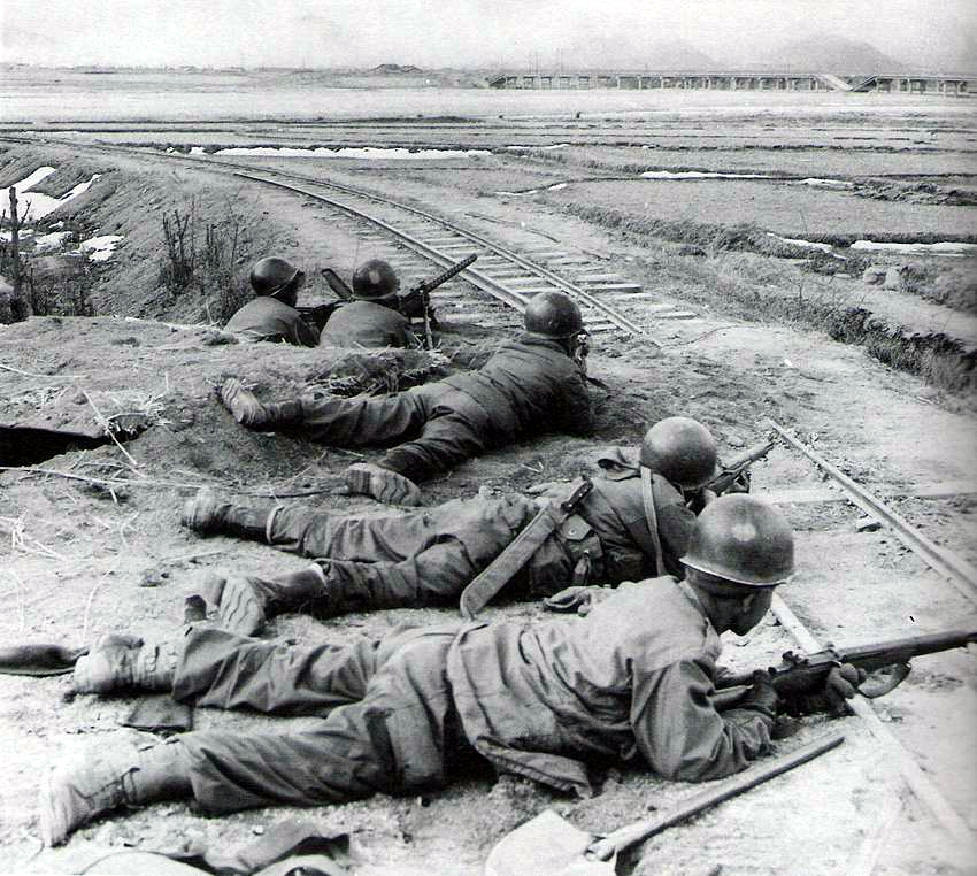
Borinqueneers man a machine gun position south of burning Oro-ri.
December
1950 (National Archives)
This is but one simple example of the Borinqueneer bravado.
These obscure days saw the birth of many a Borinqueneer hero. From
the top brass – like Lt. Col. Childs, whose conspicuous bravery and tireless
energy stimulated morale and contributed greatly to the victory throughout
the five difficult and critical days that his task force was under hostile
fire – to the lower echelons – like young Pvt. Donald Cirino Rivera, who,
whilst exposing himself to intense enemy fire in order to check fields of
fire and direct gun positions, fulfilled his duties of radio operator and
ensured the retake of his company positions.
The
Evacuation
With
the arrival of the first elements in Hŭngnam
between the tenth and the eleventh, X Corps began the evacuation for Pusan.
The corps’ objective was to carry out an orderly evacuation of all
military personnel, equipment and supplies, and certain civilian refugees.
Little equipment was to be left behind, as opposed to the 1945 Okinawa
evacuation. Part of the trophies included several 76-mm Russian-made guns
previously captured from the NKPA.
Even broken-down vehicles would be loaded and lifted out. One Time
Magazine war correspondent described this scenario: “The G.I.s left almost
nothing in wrecked Hungnam except a sardonic sign: ‘WE DON’T WANT THE DAMN
PLACE ANYWAY.’”
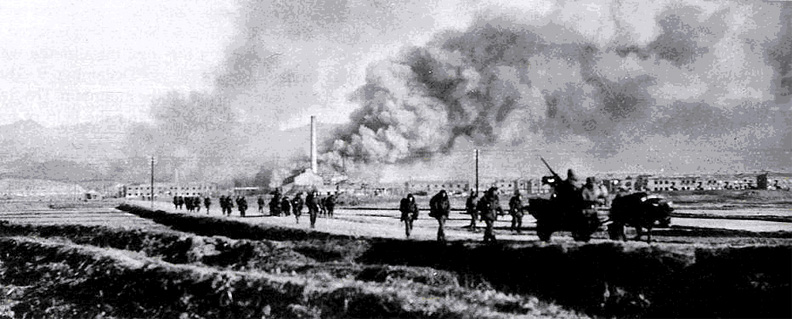
Another
burning village, courtesy of the Borinqueneers, (here using ox-carts to
transport their equipment). Near Hŭngnam, December 1950 (National Archives)
In
the personal sense, the evacuation constituted a victory for Ned Almond,
when compared with the disarray on Johnnie Walker’s
EUSAK after the loss of the 2nd Division
and most of its heavy equipment at the Kunu-ri Pass. As far as the refugees
are concerned, Almond strove to live up to his word to evacuate as many as
he could when the option of a ground evacuation was ruled out for safety
reasons. Unfortunately, of the more than 180,000 hoping to evacuate, only
91,000 would.
The
two-star had designated that the first X Corps major unit to be sealifted
would be the Marine division. Priority might have been placed on it because
of the harrowing casualty rate of more than 10,500 since its arrival in
Wŏnsan in October: 40 percent in battle and 60 percent non-battle. While
the Marines out-loaded, Almond would deploy the 3rd and 7th
divisions along the Hamhŭng–Hŭngnam sector, the 3rd taking the
left and the 7th the right. Between December 11 and 14, the
Marines would board 28 ships that, on the fifteenth, would sail for Pusan
amid a blizzard of heroic publicity. The Marines would be followed by the
ROKA I Corps, bound for Mukho, just below the 38th Parallel.
The
7th Division, 2,100 men shorter, followed suit under the covering
fire of the 3rd Division and a formidable force of about 600
planes clobbering the suspected enemy positions outside the constricted
perimeter. The concentration of U.S.
fire laid down on the enemy around the perimeter dwarfed anything ever seen
before in Korea. On the beachhead, self-propelled guns, howitzers, heavy
mortars and flak wagons put out tremendous weight of metal per mile of
front. Offshore, the warships of the Seventh Fleet sent in their own
barrage. Overhead, swarms of Air Force, Navy, and Marine Corps planes
sought out and scourged the enemy with napalm, rockets, bombs, and machine
guns. Marine veterans from World War II likened it to Iwo Jima; Army
veterans, to an “Anzio in reverse.”
In one 24-hour period, the combined firepower claimed over 2,600
CCF casualties. Demoralized by such
losses, the CCF sent regrouped
NKPA troops into the fighting,
and by the end of the week it was these who bore the brunt of the battle.
Prisoners said that every time the communists formed up for amassed attacks,
they were dispersed by shell or air attacks. From then on, enemy efforts
died down to simple probing attacks.
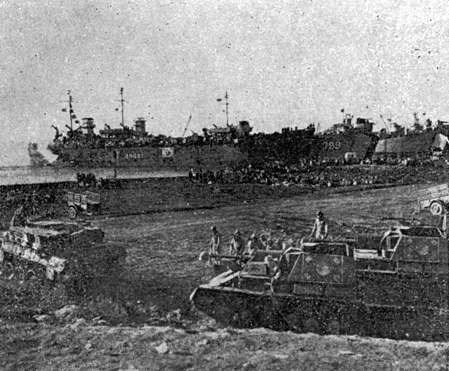
Borinqueneer troops cover the withdrawal of the X Corps.
Hŭngnam,
December 1950 (El Mundo)
At
this point, the communists headed off to a bad ending when they muffed
several excellent chances to wreck the X Corps operation. “They knew all
about us,” O.P. Smith would reflect after the battle; “where we were and
what we had. But I can’t understand their tactics. Instead of hitting us
with everything in one place, they kept on hitting us at different places.”
Whether through lack of mobility, of equipment, of tactical judgment, or a
combination of these and other factors, after the Hŭngnam perimeter had been
established, the enemy seemed unable to exploit their greatest asset:
manpower. “The only advantage they have on God’s green earth is numbers.”
In the end, they suffered casualties at least five times that of
U.S. forces.
The Hŭngnam evacuation seemed to be taking longer than
expected. To Ned Almond, nonetheless, it went “the way we planned.”
Whatever the reasons for the delay in wrapping up, the operation was having
two satisfactory results: It was showing the CCF
and the NKPA what the massed
U.S. firepower looked, sounded, and felt like; and it was killing a lot of
communists.
Enemy
attacks renewed in the wee hours of the twenty-second as Shorty Soule’s
three
U.S. RCTs
stood at the second phase line (DOG)
covering the out-loading of the last artillery units of X Corps and the
first of the 3rd Division service units. The brunt of the attack
fell on Howard St. Clair’s 1/65.
Unlike
a
previous company-level attack in which communist troops
wearing
U.S. helmets and winter clothing had been easily repulsed,
the uncanny CCF recurred to a
tactic the Borinqueneers were already familiar with: psychological warfare.
That is, large numbers (approximately
2,500)
and a lot of mass singing, bugling, and cymbal-clashing.
The ensuing battle culminated with morning
light finding about 1,000 CCF
troops lying in the snow, wounded or dead. In spite of incessant air
strafing, and a rain of shells from U.S. artillery and from warships
offshore, the enemy maintained his pressure throughout the day. At night,
star shells and flares illuminated the scene, which was the only practical
way of countering the enemy’s much annoying penchant for night fighting.

Borinqueneers set demolition charges around “Liberty City.”
December 1950 (El Mundo)
The evacuation of X Corps allowed the perimeter to shrink to
no more than ten miles around the Hŭngnam harbor on
the twenty-third, when Soule’s division stood at
the last phase line in preparation for the final withdrawal. Only a small
amount of enemy mortar and artillery fire struck the perimeter troops now,
but that did not keep the division from carrying out the demolition duties
around “Liberty City,” the C-47 Airfield, and surrounding railroads,
storehouses, bridges, and wharves.
As this move took place, the 65th was drawn into a
tighter perimeter defense around the harbor itself. An unexpected yet
welcomed lull allowed for a small awards ceremony in which Lt. Col. Childs,
as well as several Borinqueneers, received accolades from the division
commander. The corps commander would be there as well to present his
customary “impact” awards. Sfc. Nieves, who received the Silver Star for
his actions in Sudong, received a special commendation from Shorty Soule.
Almond recognized the effort of the 65th by presenting the Silver
Star to its regimental commander. A teary-eyed Bill Harris accepted the
Star on behalf of his Borinqueneers, lamenting he could not break it into
pieces and pin one on the chest of every one of his men and another over the
graves of those who had given their lives “on behalf of victory of this
cause and the cause of the democratic nations of the world.”
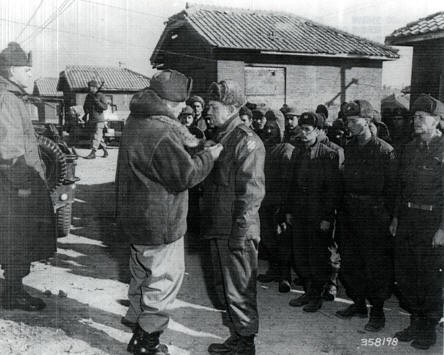
Maj.
Gen. Edward M. “Ned” Almond, CG X Corps, awards the Silver Star to Col.
Harris.
Hŭngnam,
December 1950 (National Archives)
The division received its orders to withdraw on the
twenty-fourth. The harbor was a sitting duck at this time, its perimeters
outlined by gondola cars rigged with explosives. One false move would have
sent the entire “Marne” Division sky-high.
The
final arrangement behind the last two phase lines, DOG and FOX, showed the 7th
RCT covering the left side, the
65th the middle, and the 15th the right. The order of
withdrawal once the Division Headquarters had out-loaded with all its heavy
equipment and ammunition called for the 7th
RCT to board tank landing craft (LCTs)
at half past noon, followed by the 15th
RCT
minutes later, and then the 65th. Withdrawing with two
neighboring units posed a tricky assignment for the 65th, given
that an exposed flank presented an open door for the
CCF. Accordingly, 1/65 and 3/65 retreated to Blue
Beach, occupied by 2/65, whose retreat was timed to be within minutes of the
departure of the covering force from the 15th
RCT.
Their situation was a precarious one, and the CCF
sought to exploit the present state of affairs by attacking with renewed
strength and utter disregard for the heavy toll they were paying. The enemy
on one side and the sea on the other; the situation had a romantic appeal on
the cornered Borinqueneers, who resorted to bayonets, stones, fists and
boricua-style jiu-jitsu when the Chinese – in extreme cases, carrying
the fight to the water’s edge and even on top of the ridges –
attacked with swords, maces, or nothing else but their own bodies,
staging a bizarre scene that would have certainly put the most imaginative
Hollywood screenwriter to shame. One veteran reminisces: “The only way out
for us was by ship … We opened the way so they [the division] could
retreat.”
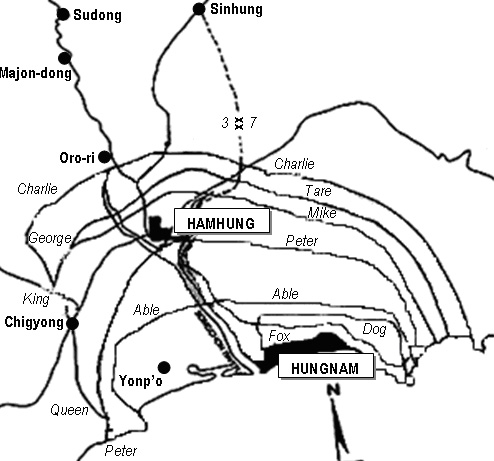
“Liberty City” and adjacencies during November and December 1950.
Close naval fire covered the Borinqueneers’ withdrawal. This posed another
tricky maneuver, for if the shells fell short of their intended targets –
the hills surrounding the dockside area – the only Hispanic outfit in the
United States Army was as good as extinct. By 1:30 p.m., under the covering
fire of 2/65, all elements had boarded landing craft. A total of four ships
lifted the RCT: two for its
personnel and two for its equipment. Wave after wave,
LCTs
ferried the drained but proud men to the awaiting ships. Many had to be
pulled up the side meshes of the Liberty class
USS
General H. B. Freeman (TAP
143). “Even on the ship that was to take us out of there,” retired Master
Sgt. Norberto Cartagena recalls, “we had to keep on firing. The Chinese and
the North Koreans were already on the pier.”
Bill
Harris’ command group loaded on the last landing craft with elements of 2/65
at 2:30 p.m. “So far as I know,” Harris would write in his memoirs, “we
were the last to leave the area.”
At 2:37 p.m. the fleet turned away and steamed south.
Behind it, the Hŭngnam Harbor sank into the ocean under one
sky-high pillar of smoke.
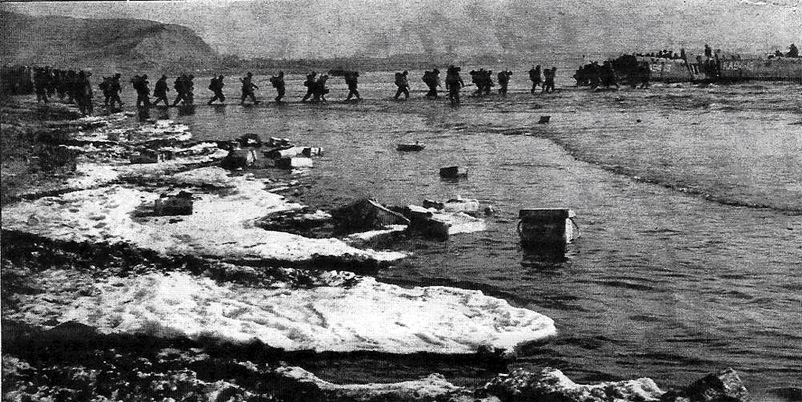
Unidentified troops
(probably Marines) “LEAVING
THE BEACH AT HUNGNAM”in
this David Douglas Duncan picture
featured in the January 8, 1951 edition of Time. The celebrated
photographer topped off his description of the action
with a
sardonic,“If the enemy had used artillery …” to illustrate the grimness of the
scenario surrounding the
X
Corps’ epic withdrawal.
A
Borinqueneer Christmas Carol
All the excitement and gut-tightening anticipation behind,
the 65th prepared to enjoy the most unforgettable Christmas Eve
many had ever had. They had proven to the toughest skeptics that the
Borinqueneers were a fighting force to be reckoned with. It had earned a
place of honor in Marine Corps history. It had survived the Korean winter
at its worst. It had safeguarded the largest sealift since World War II.
The
evacuation itself took 193 shiploads using 109 ships. Two
CCF armies (37,500 men) were
annihilated by X Corps and/or the weather during the withdrawal from
Changjin. Over 3,600 wounded and 200 vehicles were airlifted out. Hŭngnam
was destroyed. In Harris’ opinion, the overall venture constituted “a
logistic and strategic miracle.”
On board the Freeman, the exhausted Puerto Ricans were
treated like honored guests. Many, after enjoying their first hot showers
and hot meals in months, had much to thank the Lord for. Regimental
Catholic chaplain Father Ryan said a Mass, and the men sang “Noche
de Paz” (“Silent Night”) while their Continental comrades sang
“Adeste Fideles.” Colonel Harris commended his men on an unparalleled
performance, reiterating his “complete and unbending confidence in [their]
fighting ability.” Christmas Day in the morning treated the warriors with a
unique breakfast resembling nothing of the cold C rations the men got used
to, in a preamble to the heavenly evening banquet of roast turkey.
The
influx
of troops in Pusan initially overwhelmed that port’s capacity, but by New
Year’s Day the 3rd
Division was on the ground again and ready to assume its duties under
EUSAK’s
I Corps.
The Borinqueneers stood tall and ready for future triumphs in
the Land of Morning Calm.
Inasmuch as the story told in this article draws from the
sources listed below, it does not represent the official version of the
Department of Defense or the United States Army. The contents of the article
and the history it relates are solely the author’s opinion. Furthermore, he
assumes total responsibility for mistakes and/or inaccuracies incurred.
Blair, Clay. The Forgotten War: America in Korea
1950–1953. New York: Times Books, 1988.
Cowart, Glen C. “Christmas Eve: The last day at Hungnam.” The
Watch on the Rhine, December 2001. pp. 22-23.
Donaldson, Leslie. “Recalling 65th Infantry’s
triumphs, tragedies.” The San Juan Star, April 23, 2000. pp. 5-6.
(This article was published simultaneously in Spanish.)
Harris, W. W., Brigadier General, USA (Ret.). Puerto
Rico’s Fighting 65th U.S. Infantry: From San Juan to Chorwan.
California: Presidio Press, 1980.
Mossman, Billy C. Ebb and Flow: November 1950–July 1951.
Washington, D.C.:
Center of Military
History United States Army, 1990.
Norat, José A. Historia
del Regimiento 65 de Infantería
[Spanish:
History of the 65th Infantry Regiment]. San
Juan: La Milagrosa, 1960.
Ruiz, Albor. “Viequenses
Deserve Our Full Support.” New York Daily News, June 8, 2000. p. 2.
Russ, Martin. Breakout: The Chosin Reservoir Campaign,
Korea 1950. New York: Penguin Books, 2000.
Vázquez, Margarita – Author Interview, March 3, 2003. (Sgt.
Vázquez, a member of the Puerto Rico Army National Guard, is the daughter of a
Borinqueneer who served three years in Korea. Special thanks go to
Margarita.)
Villahermosa, Gilberto. Letter to Army Magazine,
September 2002.
“War in Asia.” Time Magazine (as indicated).
Wells, Robert P. Letters to the Author, December 7, 2004;
December 23, 2004; January 6, 2005. (Former Secretary and two-term President
of the 88th Division Association, Mr. Wells served in the 3rd
Division’s 3rd MP Company, an outfit closely linked to the 65th
Infantry Regiment. A special salute goes to Bob.)
______. “What a Christmas dinner!” Military Magazine,
December 2004. p. 26.
About the
Author
Luis Asencio Camacho is a Human Resources Assistant with the Army ROTC on the
Mayagüez Campus of the University of Puerto Rico. He is the author of an
unpublished historical novel on the Borinqueneers. He may be contacted at
[email protected].
Part of this problem of unpreparedness might have to do with the
standardized (perhaps compulsory) integration of ROKA troops into U.S.
Army units. The KATUSA (Korean Augmentation to the U.S. Army) program
created a serious language problem in regards to both proficiency and
terminology, as the Korean language in essence lacked virtually all the
“technological” terms existent in the English language. By the time his
regiment landed in North Korea, Bill Harris had dealt with the problem in
a very particular way: assigning just one KATUSA per squad and
“dispatching” the surplus (over 1,000) back to ROKA units. By then, the
65th’s combat readiness was that of a fully functional unit, as
opposed to the respective readiness of sister regiments, 7th
and 15th, at 50% each.
“War in Asia – The Enemy: Poor Showing,” January 8, 1951.
“War in Asia – Battle of Korea: ‘Anzio in Reverse,’” Time, January
1, 1951.
The operation plan covering the withdrawal of the 65th RCT
originally called for 1/65 and 3/65 to move back from CHARLIE Line to TARE
Line and to hold there until 2/65 leapfrogged them and took up a position
on MIKE Line. The 2/65 would, in turn, hold that position to protect the
1/65 and 3/65 movements to PETER Line, whence, once again, both battalions
would hold while 2/65 reached ABLE Line, and so on. As enemy pressure
grew stronger by the minute, a new revision of the plan was to direct 1/65
and 3/65 to hold on TARE while 2/65 passed through MIKE all the way back
to PETER; then 1/65 and 3/65 leapfrogged to ABLE. Finally, all 65th
RCT elements would move to FOX, the main line of resistance (MLR), site of
the final stand.
José F. Rodríguez, as quoted by The San Juan Star on April 23,
2000.
The issue of which regiment was the last to evacuate the beachhead has
been harshly debated by veterans from both infantry regiments (15th
and 65th). One MP in charge of a ten-man detachment assigned
to protect the 65th during this period recalls the following:
I cannot state to the
minute when either Regiment last embarked its GI’s, but will tell you the
real tale of the 65th. It took a long time for the 65th
to be loaded onto boats because they had to be so carefully channeled
between the Railroad cars that were loaded with explosives to blow up the
stone wharf. When the last units were on their way to the APA Henrico
[Freeman], Colonel Harris and his small group climbed down into
[an] LCVP, and I was one of the group. When we tied up to the steep
stairway of the Henrico it was most difficult to get me and all of
my gear onto the stairs and up them to the deck. A CPO helped me over the
rail, and then took me and what he could carry to a bunk below. Here is
the significant part. We dropped all of my gear, and returned to the deck
BECAUSE [emphasis in the original] the entire port was blown up as we
watched. This was minutes after we got aboard. It was an unforgettable
sight, and told us we were really safe! While we were still at the rail
the Battleship Missouri came close to our port side as it was
leaving the Bay. If anyone of the 15th left land after we did
they would have to have had a speedboat to get away from that explosion.
This is just an opinion. (Bob Wells, in letter to the Author, January 6,
2005)
